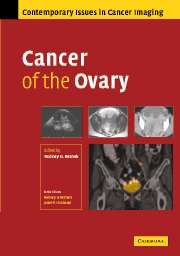Book contents
- Frontmatter
- Contents
- Contributors
- Series Foreword
- Preface to Cancer of the Ovary
- 1 Epidemiology of Ovarian Cancer
- 2 The Pathological Features of Ovarian Neoplasia
- 3 Ovarian Cancer Screening
- 4 Surgical Management of Patients with Epithelial Ovarian Cancer
- 5 Medical Treatment of Ovarian Carcinoma
- 6 Ultrasound in Ovarian Carcinoma
- 7 MR Imaging in Ovarian Cancer
- 8 CT in Carcinoma of the Ovary
- 9 PET and PET/CT in Ovarian Cancer
- Index
- Plate section
- References
5 - Medical Treatment of Ovarian Carcinoma
Published online by Cambridge University Press: 11 September 2009
- Frontmatter
- Contents
- Contributors
- Series Foreword
- Preface to Cancer of the Ovary
- 1 Epidemiology of Ovarian Cancer
- 2 The Pathological Features of Ovarian Neoplasia
- 3 Ovarian Cancer Screening
- 4 Surgical Management of Patients with Epithelial Ovarian Cancer
- 5 Medical Treatment of Ovarian Carcinoma
- 6 Ultrasound in Ovarian Carcinoma
- 7 MR Imaging in Ovarian Cancer
- 8 CT in Carcinoma of the Ovary
- 9 PET and PET/CT in Ovarian Cancer
- Index
- Plate section
- References
Summary
Introduction
Ovarian cancer is a very chemosensitive tumour with a number of classes of drugs showing activity. Major advances in treatment of newly diagnosed ovarian cancer have improved survival but most patients relapse and require further treatment and only a minority of patients with advanced disease achieve long-term survival. Research is directed towards finding new effective agents and regimes with minimum toxicities.
Chemotherapy in Early Stage Disease
Two prospective, randomised trials of patients with stage Ia or Ib disease with well or moderately differentiated cancers demonstrated a 5-year survival of over 90% with surgery alone. 81 patients were randomized after surgery to receive oral melphalan (0.2 mg/kg/day for 5 days) or no further treatment. There were no significant differences between the no chemotherapy and the melphalan arms with respect to either 5-year disease-free survival (91% vs. 98%; p = 0.41) or overall survival (94% vs. 98%; p = 0.43). In the second trial, 141 patients with poorly differentiated stage I or stage II disease received either melphalan (as above) or a single intraperitoneal dose of P32 at the time of surgery. The outcomes for the two treatment groups were similar. 5 year disease-free survival (DFS) was 80% in both groups and overall survival was 81% with melphalan versus 78% with P32; p = 0.48 [1]. An Italian group studied 271 patients with moderate or poorly differentiated stage Ia, b and c disease. Patients were randomised to Cisplatinum (50 mg/m2 with repeated courses every 28 days for 6 cycles) versus observation versus P32.
- Type
- Chapter
- Information
- Cancer of the Ovary , pp. 82 - 93Publisher: Cambridge University PressPrint publication year: 2006

